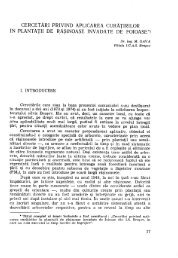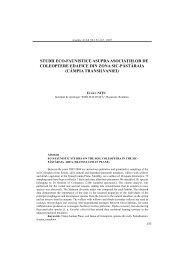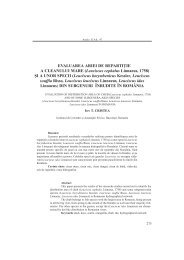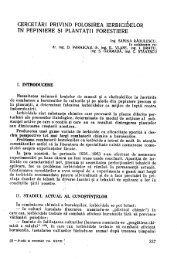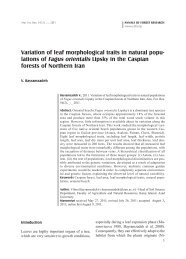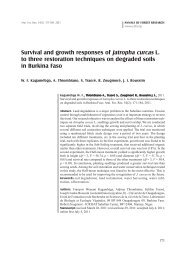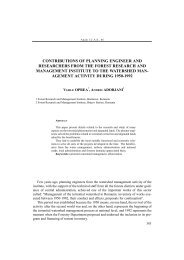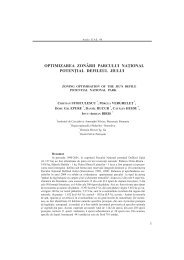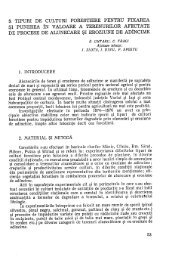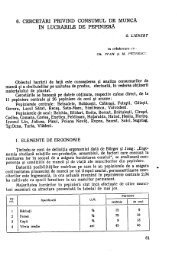Romania (Quercus cerris, Q. frainetto, Q. robur) and - EdituraSilvica.ro
Romania (Quercus cerris, Q. frainetto, Q. robur) and - EdituraSilvica.ro
Romania (Quercus cerris, Q. frainetto, Q. robur) and - EdituraSilvica.ro
Create successful ePaper yourself
Turn your PDF publications into a flip-book with our unique Google optimized e-Paper software.
Fodor et al. Mycorrhizal status of several <st<strong>ro</strong>ng>Quercus</st<strong>ro</strong>ng> species in <st<strong>ro</strong>ng>Romania</st<strong>ro</strong>ng> ...Table 4 The Yule coefcient of association of Cenococcum geophilum with several other mycorrhizal morphotypes in <st<strong>ro</strong>ng>Quercus</st<strong>ro</strong>ng> <st<strong>ro</strong>ng>cerris</st<strong>ro</strong>ng>, DobretiAssociationYule coefcient of associationC. geophilum + M10 -0.8004C. geophilum + M17 -0.1287C. geophilum + M8 0.2564C. geophilum + M3 0.2467C. geophilum + M11 -0.0943C. geophilum associates either r<st<strong>ro</strong>ng>and</st<strong>ro</strong>ng>omlywith other morphotypes in the same mycorrhizalsystem (values close to 0), or excludesother morphotypes (value close to -1 in the associationwith M10) according to our results, apattern consistent with its dominating position.It is also the most frequent <st<strong>ro</strong>ng>and</st<strong>ro</strong>ng> b<strong>ro</strong>ad spectrumhost associated mycorrhizal type as other authorsreport (Moser et al. 2005).The comparison of the mycorrhizal status(relative frequencies of active mycorrhizal apices)among 5 samples of <strong>ro</strong>ots f<strong>ro</strong>m <st<strong>ro</strong>ng>Quercus</st<strong>ro</strong>ng><st<strong>ro</strong>ng>cerris</st<strong>ro</strong>ng> at Dobreti by of one way ANOVA resultedin no signicant differences at p > 0.05.Also Tukey test for pair-wise multiple comparisonsdidn’t reveal any signicant differencesbetween samples.Søresen similarity index (Table 4) calculatedin order to compare locations <st<strong>ro</strong>ng>and</st<strong>ro</strong>ng> <st<strong>ro</strong>ng>Quercus</st<strong>ro</strong>ng>species (within site <st<strong>ro</strong>ng>and</st<strong>ro</strong>ng> between sites) showmaximum values in the following cases: <st<strong>ro</strong>ng>Quercus</st<strong>ro</strong>ng><st<strong>ro</strong>ng>frainetto</st<strong>ro</strong>ng> at Tinca with <st<strong>ro</strong>ng>Quercus</st<strong>ro</strong>ng> <st<strong>ro</strong>ng>cerris</st<strong>ro</strong>ng> atOradea (0.72), <st<strong>ro</strong>ng>Quercus</st<strong>ro</strong>ng> <st<strong>ro</strong>ng><strong>ro</strong>bur</st<strong>ro</strong>ng> at Buteni with<st<strong>ro</strong>ng>Quercus</st<strong>ro</strong>ng> <st<strong>ro</strong>ng><strong>ro</strong>bur</st<strong>ro</strong>ng> in the city of Oradea (0.61),<st<strong>ro</strong>ng>Quercus</st<strong>ro</strong>ng> <st<strong>ro</strong>ng>cerris</st<strong>ro</strong>ng> <st<strong>ro</strong>ng>and</st<strong>ro</strong>ng> <st<strong>ro</strong>ng>Quercus</st<strong>ro</strong>ng> <st<strong>ro</strong>ng>frainetto</st<strong>ro</strong>ng> at MihaiBravu (0.57).The analysis of the dend<strong>ro</strong>gram resultedf<strong>ro</strong>m the ordination of Sørensen similarity matrix,comparing different sites <st<strong>ro</strong>ng>and</st<strong>ro</strong>ng> tree hostswith regard to identied morphotypes (Fig. 3),reects the association between similar siteswithin same geographical <st<strong>ro</strong>ng>and</st<strong>ro</strong>ng> meso-climaticarea. Within same location, different host speciesare highly similar with respect to their mycorrhizalassociates, such as Q. <st<strong>ro</strong>ng>cerris</st<strong>ro</strong>ng> <st<strong>ro</strong>ng>and</st<strong>ro</strong>ng> Q.<st<strong>ro</strong>ng>frainetto</st<strong>ro</strong>ng> at Dobreti or Tinca (South-West atMihai Bravu).A distinct cluster is formed by hosts locatedin forest st<st<strong>ro</strong>ng>and</st<strong>ro</strong>ng>s f<strong>ro</strong>m Southern <st<strong>ro</strong>ng>Romania</st<strong>ro</strong>ng> wherethese are vegetating in the plain <st<strong>ro</strong>ng>and</st<strong>ro</strong>ng> are exposedto temperate-continental climate withharsh winters <st<strong>ro</strong>ng>and</st<strong>ro</strong>ng> dry summers. Another distinctcluster is formed by hosts vegetating inst<st<strong>ro</strong>ng>and</st<strong>ro</strong>ng>s f<strong>ro</strong>m Mihai Bravu, in the Neajlov riverdelta, characterized by wetter soil conditionsas compared to other Southern locations. However,Q. <st<strong>ro</strong>ng>frainetto</st<strong>ro</strong>ng> f<strong>ro</strong>m Comana, a nearby location,to Mihai Bravu clusters together withother Southern locations characterized bydrier soil conditions. North Western locationscluster, together presents same pattern of associationwith their mycobionts, including aslocation Tinca <st<strong>ro</strong>ng>and</st<strong>ro</strong>ng> Oradea. <st<strong>ro</strong>ng>Quercus</st<strong>ro</strong>ng> <st<strong>ro</strong>ng><strong>ro</strong>bur</st<strong>ro</strong>ng> ishighly dissimilar to other host species withregard to associated mycobionts <st<strong>ro</strong>ng>and</st<strong>ro</strong>ng> clustersseparately. Recurrent associations, in this caseof ectomycorrhizal mophotypes, correspondto fundamental p<strong>ro</strong>perties of the interactionbetween species <st<strong>ro</strong>ng>and</st<strong>ro</strong>ng> their physical (site) <st<strong>ro</strong>ng>and</st<strong>ro</strong>ng>biotic envi<strong>ro</strong>nment (hosts) (Legendre & Legendre,1998).Previous studies (Timofte 2007) reported thepossibility to obtain mic<strong>ro</strong>p<strong>ro</strong>pagated plantletsof Q. <st<strong>ro</strong>ng><strong>ro</strong>bur</st<strong>ro</strong>ng> <st<strong>ro</strong>ng>and</st<strong>ro</strong>ng> Q. <st<strong>ro</strong>ng>frainetto</st<strong>ro</strong>ng> by means of somaticembryogenesis initiated f<strong>ro</strong>m acorns.The embryos can be converted to plantletswhich, theoretically, can be outplanted.DiscussionThe energy ow th<strong>ro</strong>ugh the mycorrhizal networksrepresents a major food chain in the forestt<strong>ro</strong>phic web. The network represented by67



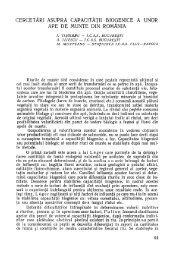
![studiu privind conditiilb] de vegetatie ale ... - EdituraSilvica.ro](https://img.yumpu.com/50877313/1/175x260/studiu-privind-conditiilb-de-vegetatie-ale-editurasilvicaro.jpg?quality=85)

